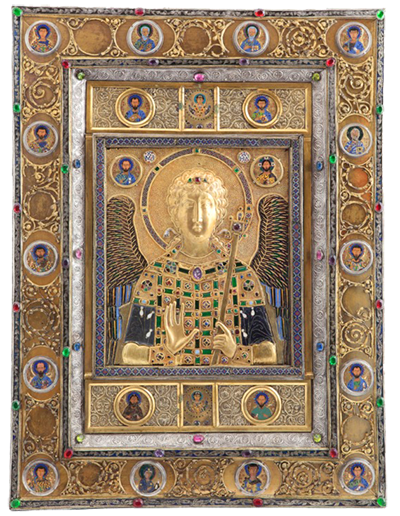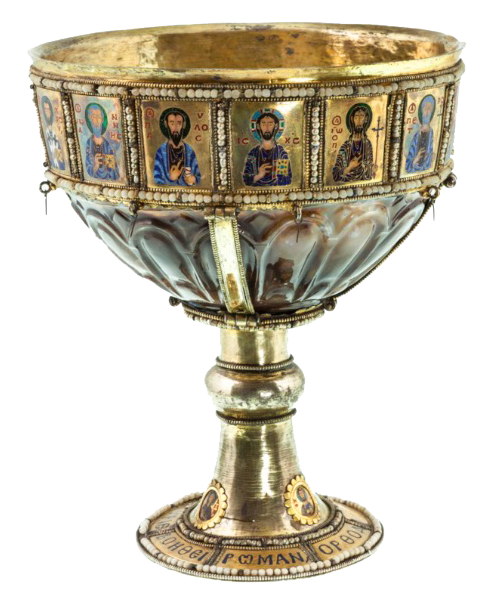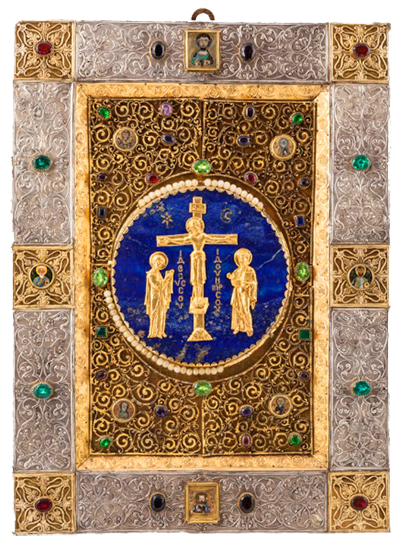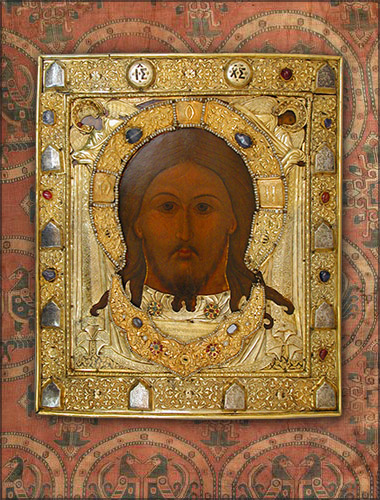![]()
Icon of St. Michael the Archangel
This icon was looted from Constantinople during the Fourth Crusade and is now in the treasury of St. Mark's Cathedral in Venice. It is dated to the late 11th or early 12th centuries. It is 18 inches tall and 14 inches in width. Made of gilt-silver and enamel, it is set with gemstones and glass. The gold cloisonne enamel work is amazing workmanship. It is impossible to know where this icon was kept in Constantinople, there are no records of its origin. Its size and opulence indicate it came from a private Imperial chapel.
Our Lady of the Pharos and St. Stephen's Chapel in the grounds of the Great Palace both had treasure houses of relics and precious works of art like this.
The icon of the Archangel is surrounded an entourage of military saints in enamel and points to his role as the the leader of the celestial army.
 Icon Panel of the Archangel Michael
Icon Panel of the Archangel Michael
The icon was looted from Constantinople in 1204 and now in the treasury of St. Mark's in Venice. It is 17 inches tall and 14 inches wide. It is made of silver-gilt, enamel, precious stones, pearls and glass and is dated to the late tenth or early eleventh centuries. The use of such images has been debated over the years, they could have been placed in a chapel iconostasis or carried in processions. Such and icon would be appropriate in a funeral chapel or a shrine to the Archangel himself.
The Emperor Issac II Angelos, one of the last Byzantine Emperors before the Fourth Crusade, poured enormous sums into a church he built for the Archangel near Constantinople, icons like this would have been part of its decoration.
 Chalice of the Emperor Romanos II
Chalice of the Emperor Romanos II
Created between 959-963, possibly from Hagia Sophia and looted in 1204. It is now in the treasury of Saint Mark's in Venice. It is 9 inches tall and 6 inches wide. The communion chalice is made of silver-gilt, gold cloisonne enamel, stones, pearls and glass. The cup is carved in sardonyx.
Gold - Silver - Lapis Icon with Jewels and Enamels
Many of the Byzantine objects in the Treasury of Saint Mark's have been altered or added to. Some are even new inventions from the late in the 13th century. This always makes me hesitate when I use pictures like these and don't explain their origin. The Venetians employed Greek goldsmiths, but they were so good at making treasures like this that they really didn't need them. It seems certain to me that the last remaining Greek enamelers would have left Constantinople after 1204. There was a little work for the Latin Emperors but they employed western goldsmiths who were working in Constantinople. Prior to 1204 the city was full of Latin merchants and many stayed after city fell. The Imperial workshops that made beautiful things like this - the enamelers especially - were employees of the Imperial workshops. They received annual commissions from the court and also produced other things as directed by their masters or the court officials they were responsible to. The workshops - even when they were at peak production - probably only made a couple hundred enamels. The master craftsmen had many apprentices who assisted them and where in training themselves. Since enamels began to appear in the 9th century the technical abilities of the workshop by the 12th century they had reached a level that was not surpassed until Faberge in Russia. I am sure the workshops that produced enamels also made silver and gold things for the emperor. Almost all of this production was given as gifts by him. Some things were special orders and others where produced and kept in storage to be used as the need arose.
The Imperial court needed precious thing right up until the end. in 1200 there was one of the last great Imperial celebrations - a wedding in Blachernae - that would have required all sorts off precious things. Every year or so all the Imperial princes had to get new headgear that had enameled portrait of the ruler on the front and back of it. The emperor also sent gifts of gold, gems, pearls and enamel to other rulers as guests. Whenever he traveler he carried gifts for important people he met along the way. The Imperial Workshop was obviously very busy until 1200 or so.
To return to this beautiful lapis and silver gilt (the figures and inlaid letters on the lapis disc are solid gold) icon it was assembled and added to after 1204 in Venice from Byzantine bits and new bits in Byzantine style. The silver panels are gorgeous. It is Byzantine, not Venetian.





 click here for icons of christ
click here for icons of christ click here for icons of the theotokos
click here for icons of the theotokos click here for icons of angels
click here for icons of angels click here for icons of saints
click here for icons of saints








